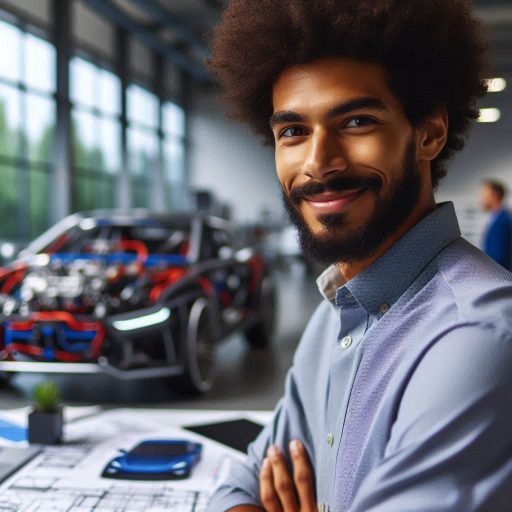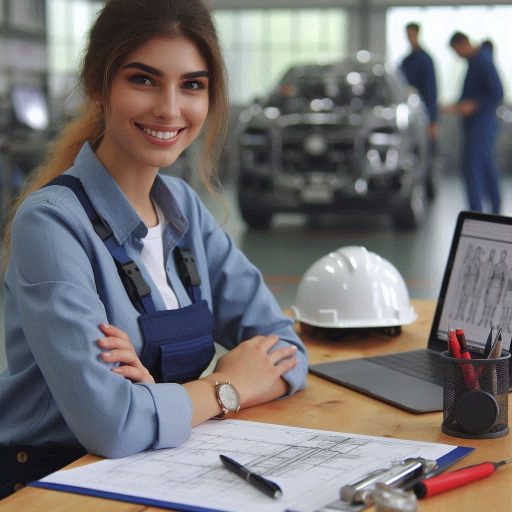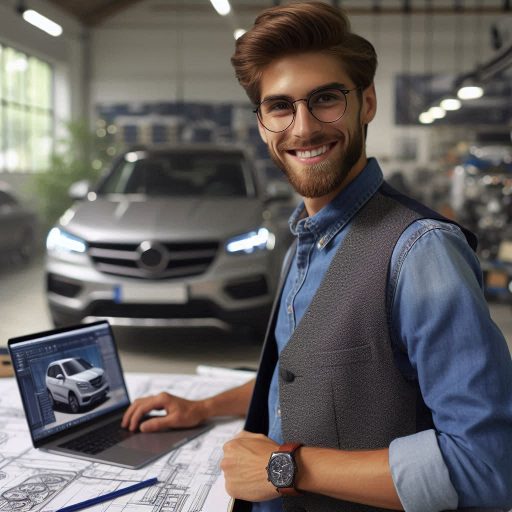Introduction
An automotive designer is responsible for creating the visual and ergonomic aspects of vehicles.
Automotive design plays a crucial role in shaping consumer preferences and industry trends.
Every day starts with sketching new ideas and concepts, researching market trends, and collaborating with engineers and stakeholders.
The designer converts initial sketches into digital models using computer-aided design software and 3D visualization tools.
Throughout the day, designers participate in meetings with cross-functional teams to discuss design changes, progress, and feedback.
Inspecting physical prototypes is crucial to evaluate the design’s feasibility, aesthetics, and functionality.
Interacting with clients to understand their preferences and brand image, and incorporating feedback into design revisions.
Collaborating with engineers to ensure that the design meets regulatory standards, safety requirements, and performance expectations.
Wrapping up the day by reviewing the day’s progress, setting goals for the next day, and finalizing any pending design tasks.
Background of an Automotive Designer
In order to become an automotive designer, a solid educational background and specific skillset are essential.
Let’s delve into the necessary requirements for this unique and creative profession.
Required Education for Becoming an Automotive Designer
A Bachelor’s degree in Industrial Design, Transportation Design, or Automotive Engineering is typically required.
Some designers also pursue a Master’s degree to further enhance their skills and knowledge.
Specialized courses in sketching, 3D modeling, and computer-aided design (CAD) are important in this field.
Internships or co-op programs with automotive companies can provide valuable hands-on experience.
Continuous learning and staying updated on industry trends and technologies are crucial for career growth.
Skills Needed for Becoming an Automotive Designer
Strong artistic and creative abilities are fundamental for developing innovative and visually appealing designs.
Excellent drawing and sketching skills are essential to effectively communicate design concepts.
Proficiency in 2D and 3D software such as Adobe Illustrator, Photoshop, and Alias is important for design visualization.
Understanding of automotive engineering principles and manufacturing processes is beneficial for practical design implementation.
Transform Your Career Today
Unlock a personalized career strategy that drives real results. Get tailored advice and a roadmap designed just for you.
Start NowCommunication skills are vital for collaborating with cross-functional teams and presenting design proposals.
Typical Work Environment of an Automotive Designer
Automotive designers work in a fast-paced and dynamic environment that requires creativity, innovation, and attention to detail.
Let’s explore the typical work environment of an automotive designer:
Design Studios
Automotive designers often work in design studios within automotive companies, where they collaborate with other designers and engineers.
Design studios are equipped with advanced design software, prototyping tools, and other resources to support the design process.
Design studios provide a creative space for designers to brainstorm ideas, sketch concepts, and develop innovative designs.
Collaborative Work Environment
Automotive designers work closely with cross-functional teams, including engineers, marketers, and product managers, to bring designs to life.
Collaboration is key in the design process, as designers need to align their creative vision with technical feasibility and market requirements.
Team meetings, design reviews, and brainstorming sessions are common in the collaborative work environment of an automotive designer.
Client Interaction
Automotive designers may interact with clients, stakeholders, and senior management to present design proposals and gather feedback.
Client feedback and market research play a crucial role in shaping the final design direction and ensuring customer satisfaction.
Effective communication and presentation skills are important for engaging clients and addressing their design requirements and preferences.
In essence, becoming an automotive designer requires a combination of education, skills, creativity, and teamwork.
The work environment of an automotive designer is dynamic, collaborative, and rewarding, offering unique opportunities for creative expression and innovation in the automotive industry.
Read: Tools and Software for Automotive Designers
Daily Tasks of an Automotive Designer
Designing a New Car
As an automotive designer, my day starts with brainstorming new ideas for the design of upcoming car models.
This involves researching market trends, customer preferences, and technological advancements in the automotive industry.
Once the concept is finalized, I start sketching out the initial designs on paper or using digital design software.
This phase is crucial as it sets the foundation for the entire design process.
After refining the initial sketches, I create detailed 3D models of the car using computer-aided design (CAD) software.
Transform Your Career Today
Unlock a personalized career strategy that drives real results. Get tailored advice and a roadmap designed just for you.
Start NowThis allows me to visualize the design from every angle and make necessary adjustments to ensure both aesthetic appeal and functionality.
Next, I collaborate with a team of engineers to assess the feasibility of the design in terms of performance, safety, and manufacturing processes.
This iterative process involves constant communication and problem-solving to overcome any design challenges.
Once the design is approved, I work closely with prototype builders to create physical prototypes of the car.
This step is crucial to testing the design in real-world conditions and making any final adjustments before production.
Finally, I oversee the transition of the design from prototype to mass production, working closely with manufacturers and suppliers to ensure that the final product meets the high standards set during the design phase.
Collaboration with Team Members
Working as an automotive designer also involves collaborating with a diverse team of professionals, including engineers, marketers, and product developers.
Throughout the design process, I work closely with engineers to ensure that the design meets technical requirements and can be successfully implemented in production.
This collaborative effort helps to streamline the design process and address any technical challenges early on.
Additionally, I collaborate with marketers to understand consumer preferences and market trends, ensuring that the final design resonates with target customers and aligns with the brand’s positioning in the market.
Teamwork is key in the automotive design industry, as each team member brings a unique set of skills and perspectives to the table.
By working together, we can create innovative and visually appealing designs that meet the needs and expectations of consumers.
In fact, the daily tasks of an automotive designer involve a combination of creativity, technical expertise, and collaboration with cross-functional teams.
From concept development to production, the design process requires attention to detail, problem-solving skills, and a passion for creating cutting-edge automotive designs.
Read: Automotive Design Trends in 2024
Tools and Software Used by Automotive Designers
Automotive designers use a variety of tools and software to bring their creative ideas to life.
These tools assist them in designing cars that are not only visually appealing but also functional and safe.
Sketching Supplies
One of the most basic tools for automotive designers is a set of sketching supplies.
These include pencils, markers, and sketch pads, which allow designers to quickly jot down their ideas for new car designs.
Computer-Aided Design (CAD) Software
CAD software is an essential tool for automotive designers.
Transform Your Career Today
Unlock a personalized career strategy that drives real results. Get tailored advice and a roadmap designed just for you.
Start NowIt allows them to create detailed 3D models of their designs, which can then be easily modified and refined.
This software helps designers visualize their concepts more accurately and make changes quickly.
Adobe Creative Suite
Adobe Creative Suite is another crucial software used by automotive designers.
It includes programs like Photoshop and Illustrator, which designers use to create renderings and illustrations of their designs.
These tools help designers convey their ideas more effectively to clients and colleagues.
Clay Modeling Tools
Clay modeling tools are used by automotive designers to create physical models of their designs.
These models allow designers to see how a car will look in real life and make adjustments to the design as needed.
Clay modeling tools are crucial for designers to get a sense of the proportions and scale of a vehicle before it goes into production.
Virtual Reality (VR) Software
Some automotive companies use virtual reality software to visualize and test their designs in a virtual environment.
This software allows designers to see how a car will look and perform before it is built, saving time and resources in the design process.
Overall, the tools and software used by automotive designers play a vital role in helping them bring their ideas to life.
From sketching supplies to CAD software and virtual reality tools, each of these tools contributes to the design process and ensures that the final product meets the highest standards of quality and innovation.
Read: Famous Automotive Designers in History

Challenges Faced by Automotive Designers
Designing cars is an exciting field, but it comes with its own set of challenges.
Automotive designers constantly face pressure to create unique and innovative designs that stand out in a crowded market.
Pressure to Create Unique and Innovative Designs
Automotive designers are under constant pressure to push the boundaries of traditional design and come up with fresh ideas.
There is a need to balance creativity with practicality, ensuring that the final design is not only visually appealing but also functional.
Clients and consumers expect designers to deliver something new and groundbreaking, which can be a daunting task.
Designers must strive to create designs that resonate with the target audience while also setting trends in the industry.
Competition is fierce in the automotive design world, driving designers to think outside the box and innovate constantly.
Transform Your Career Today
Unlock a personalized career strategy that drives real results. Get tailored advice and a roadmap designed just for you.
Start NowKeeping Up with Trends in the Industry
Staying up-to-date with the latest trends in automotive design is crucial for designers to remain relevant and competitive.
Technology is advancing rapidly, influencing design trends and changing consumer preferences, making it essential for designers to adapt.
Environmental concerns and sustainability have become significant factors in design, requiring designers to incorporate eco-friendly elements in their work.
Designers must also consider cultural and societal influences that shape design trends and appeal to diverse global markets.
Keeping a finger on the pulse of the industry helps designers anticipate future trends and stay ahead of the curve.
Overall, automotive designers face a myriad of challenges that require creativity, innovation, and adaptability to succeed in this dynamic and competitive field.
By embracing these challenges, designers can continue to push the boundaries of automotive design and shape the future of transportation.
Read: Automotive Designer Salary Guide
Find Out More: Navigating the Job Market for New Architects
Career Growth Opportunities for Automotive Designers
As an automotive designer, there are several career growth opportunities that you can explore.
Here are some of the paths available to you:
Senior Designer
After gaining experience in the field, you can progress to a senior designer role where you will oversee projects and mentor junior designers.
Design Director
With continued success and leadership skills, you may be promoted to a design director position where you will be in charge of the overall design direction of a company.
Creative Director
For those with a strong creative vision and strategic thinking, becoming a creative director is a possibility.
This role involves setting the creative direction for a company or design team.
Design Consultant
If you have a wealth of experience and knowledge in automotive design, you could venture into consulting.
As a design consultant, you can work with various companies on specific projects or provide expert advice.
Entrepreneur
For automotive designers with a knack for business, starting your own design firm or consultancy is a viable option.
This will give you the freedom to work on projects that align with your vision and values.
Overall, the potential for advancement within the field of automotive design is significant.
Transform Your Career Today
Unlock a personalized career strategy that drives real results. Get tailored advice and a roadmap designed just for you.
Start NowWith dedication, hard work, and a passion for creativity, you can carve out a successful and fulfilling career in this dynamic industry.
Personal Qualities and Traits of Successful Automotive Designers
When it comes to being a successful automotive designer, there are certain personal qualities and traits that are essential for excelling in this field.
These qualities not only help in creating innovative and appealing designs but also in working effectively within a team and communicating ideas clearly.
Let’s take a look at some of the key qualities that are important for automotive designers:
Creativity
Creativity is at the core of automotive design, as designers are tasked with coming up with unique and innovative ideas for vehicle exteriors and interiors.
Being able to think outside the box and envision new concepts is crucial for staying ahead in the competitive automotive industry.
From sketching initial concepts to creating detailed 3D models, a creative mindset is what sets exceptional automotive designers apart.
Attention to Detail
Attention to detail is another important quality for automotive designers, as even the smallest design elements can make a big difference in the overall look and feel of a vehicle.
Being able to focus on intricate details such as the curvature of body lines, the placement of lights, and the texture of materials is essential for creating visually stunning designs.
By paying close attention to every aspect of a design, automotive designers can ensure that their creations are not only aesthetically pleasing but also practical and functional.
Strong Communication Skills
Effective communication is key when working as part of a team of designers, engineers, and other professionals in the automotive industry.
Being able to clearly articulate ideas, provide feedback, and collaborate with colleagues is essential for bringing designs from concept to production.
Strong communication skills also help automotive designers present their ideas to clients and stakeholders, gaining buy-in for their design concepts and vision.
Teamwork
Collaboration is a critical aspect of automotive design, as designers must work closely with engineers, marketers, and other team members to bring a vehicle to life.
Being able to contribute to a team dynamic, share ideas, and listen to feedback is essential for creating successful automotive designs.
By working together towards a common goal, automotive designers can leverage each other’s strengths and expertise to create innovative and impactful designs.
In a nutshell, the personal qualities and traits of successful automotive designers play a vital role in shaping the future of vehicle design.
Creativity, attention to detail, strong communication skills, and teamwork are all essential for thriving in this fast-paced and dynamic industry.
By honing these qualities, aspiring automotive designers can set themselves up for a successful and fulfilling career in automotive design.
Delve into the Subject: Storyboard Artist Job Outlook and Salary Info
Transform Your Career Today
Unlock a personalized career strategy that drives real results. Get tailored advice and a roadmap designed just for you.
Start NowConclusion
Being an automotive designer requires creativity, attention to detail, and a passion for cars.
Every day starts with researching the latest trends in design and technology.
Sketching ideas for new vehicle designs is a crucial part of the process.
Collaboration with engineers and manufacturers is key to creating feasible designs.
Presenting designs to clients and getting feedback is a continuous cycle of improvement.
Using advanced software like CAD to create detailed 3D models of the designs.
Visiting auto shows and expos to stay inspired and connected with the industry.
Attention to detail is essential during the final stages of design refinement.
Automotive designers play a vital role in shaping the future of the automotive industry.
Their creativity and innovation drive the development of new and exciting vehicle designs.
By staying on top of trends and technology, designers ensure the industry remains dynamic and competitive.
Their collaboration with engineers and manufacturers is essential for bringing designs to life.
Overall, automotive designers are the visionaries behind the cars of tomorrow.




